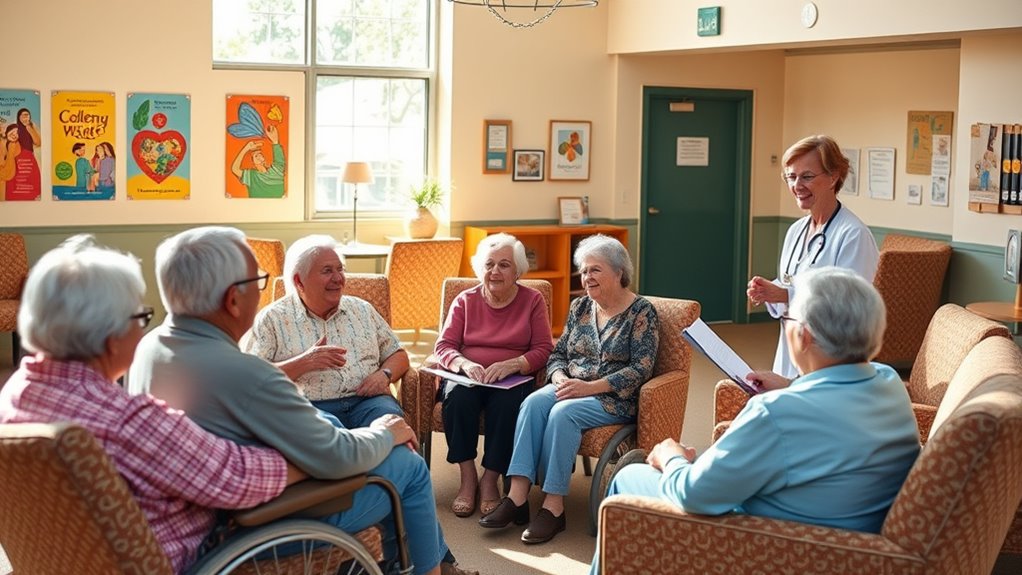Creating a support network for seniors involves connecting community resources, family, and healthcare providers to guarantee their safety and well-being. You can foster strong relationships through local organizations, volunteer programs, and technology that keeps everyone in touch. Regular communication helps coordinate care, reduce isolation, and address daily needs efficiently. By blending community involvement with digital tools, you build a seamless, responsive support system. Keep exploring to learn how these strategies can transform senior care.
Key Takeaways
- Establish strong community connections through local organizations, volunteers, and social activities to foster belonging and support.
- Integrate user-friendly technology like tablets and wearables for communication, health monitoring, and safety.
- Coordinate care among caregivers, healthcare providers, and family using digital tools to ensure seamless service delivery.
- Provide training and resources to seniors to help them comfortably adopt technology and stay engaged.
- Develop personalized care plans that include emotional support, regular check-ins, and mindfulness practices to enhance resilience.

Are you aware of how essential a strong support network is for seniors? Building a reliable system isn’t just about having friends and family nearby; it’s about creating a coordinated approach that guarantees their physical, emotional, and social needs are met seamlessly. Community engagement plays a significant role here. When you actively involve local organizations, faith groups, and volunteer programs, you foster a sense of belonging and safety for seniors. These groups can provide regular companionship, assist with errands, or even facilitate transportation to medical appointments. By tapping into community resources, you help seniors stay connected and active, reducing feelings of isolation that often accompany aging.
Building a support network for seniors involves community involvement that fosters belonging and reduces isolation.
Technology integration further enhances this support network. Modern tools like smartphones, tablets, and wearable devices enable seniors to stay in touch with loved ones effortlessly. Video calls, messaging apps, and social media platforms allow for instant communication, making it easier for family members and caregivers to monitor their well-being. Additionally, health monitoring devices can transmit essential signs directly to healthcare providers, allowing for prompt intervention if issues arise. These innovations not only improve safety but also promote independence, giving seniors confidence to manage daily activities.
For a truly effective support system, you need to blend community engagement with technology integration thoughtfully. Encourage seniors to participate in local clubs, classes, or volunteer opportunities, fostering social connections that boost mental well-being. Simultaneously, introduce them to user-friendly technology that complements their lifestyle, ensuring they’re comfortable using these tools. Training sessions or tutorials can make a significant difference, helping seniors overcome apprehensions about new gadgets.
Moreover, coordinate between different entities—healthcare providers, community groups, and family members—to create a detailed care plan. Utilizing digital platforms can streamline communication, scheduling, and documentation, making it easier to track health updates and coordinate services. This integrated approach prevents gaps in care, minimizes misunderstandings, and ensures everyone involved is on the same page. Emphasizing the importance of mindfulness in daily routines can also reduce stress and improve emotional resilience among seniors, further supporting their overall well-being.
In essence, creating a support network for seniors requires intentional effort to foster community engagement and leverage technology. When you bring these elements together, you build a safety net that not only addresses immediate needs but also promotes long-term well-being. This coordinated care approach empowers seniors to live more independently while feeling supported, valued, and connected. It’s about ensuring they know they’re not alone, and that help is always within reach—whether through a friendly visit, a quick text, or a detailed health monitoring system.
Frequently Asked Questions
How Do I Start Building a Support Network for My Senior Loved One?
To start building a support network for your senior loved one, first identify their needs and connect with local community involvement groups. Reach out to neighbors, friends, and family for assistance. Enroll in caregiver training programs to better understand how to support them effectively. This approach helps you develop a coordinated care plan, ensuring your loved one receives all-encompassing support while strengthening community ties and your confidence as a caregiver.
What Are Common Challenges Seniors Face When Accessing Coordinated Care?
You’ll face common challenges like transportation barriers that make it hard to attend appointments and medication management issues leading to confusion or missed doses. These obstacles can feel overwhelming, but recognizing them is the first step. You can seek solutions like transportation services or medication organizers. Staying proactive helps guarantee your loved one receives seamless care and maintains their well-being, despite these hurdles.
How Can Technology Enhance a Senior’S Support Network?
Technology can considerably enhance your support network by enabling virtual health services and remote monitoring. With virtual health, you can easily connect with healthcare providers from home, saving time and effort. Remote monitoring devices keep track of your essential signs and health data in real-time, alerting you and your caregivers to potential issues early. These tools make managing your health more convenient, proactive, and connected, ensuring you receive timely support when needed.
What Roles Do Family and Friends Play in Coordinated Senior Care?
Did you know that family and friends provide over 80% of emotional support for seniors? In coordinated senior care, your role is essential—offering companionship, understanding caregiver responsibilities, and helping manage daily tasks. Your involvement ensures seniors feel valued and secure, making a significant difference in their well-being. By actively participating, you help create a strong support network that promotes independence and enhances quality of life.
How Do I Ensure the Support Network Remains Effective Over Time?
To make certain your support network stays effective, focus on ongoing communication and proactive adjustments. Regularly check in with family, friends, and care providers to address any changes in needs or circumstances. Stay flexible and open to making adjustments as situations evolve. This ongoing dialogue helps prevent issues from escalating and keeps everyone aligned, ensuring your loved one’s care remains consistent and responsive over time.
Conclusion
So, next time you think a single doctor or a lonely alarm system will do the trick, remember: seniors deserve more than just a “one-man” show. A coordinated support network isn’t just a fancy idea—it’s the lifeline that keeps independence alive and stress at bay. After all, who wants to be the hero of a solo act when teamwork can turn aging into a well-rehearsed symphony? Support network—because seniors deserve an all-star cast.









